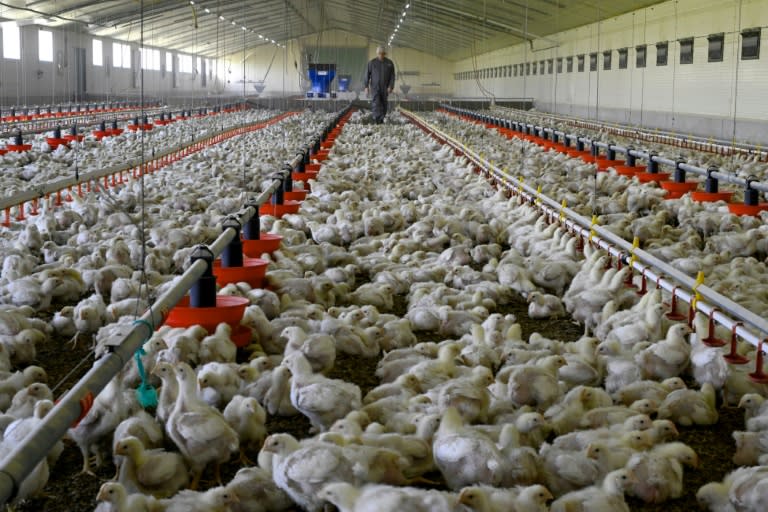Chicken instead of steak? A solution for the climate, not necessarily for the rest

In the west of France, a breeder watches over a shed of 30,000 chickens. In less than a month, their weight will more than triple and their meat will have a reduced carbon footprint.
“The objective is to make the best possible meat, in the shortest possible time and with the least amount of food possible,” summarizes Stéphane Dahirel, 56, at the head of this operation in central Brittany.
The white plumage of the birds is sparse: they hatched 20 days ago. But they already weigh almost a kilo, 20 times more than at birth. When they are slaughtered, at 45 days, they will weigh more than 3 kg.
And their large chest will yield a lot of fillet – the part most appreciated by Western consumers – which will end up in particular as “nuggets” for McDonald’s.
This accelerated yield allows chicken to have the lowest carbon footprint of meat, in France or elsewhere. Eaten on all continents, chicken would therefore be a solution from a strict climatic point of view, if it were to replace beef… Not insignificant, when we know that breeding represents around 10 to 20% of human greenhouse gas emissions, according to sources.
But to have chickens, you have to produce the grains that feed them, which involves large cultivated areas, synthetic fertilizers, pesticides… With consequences on biodiversity, water quality, deforestation. Not to mention animal welfare.
Chicken generates “less than a kilo” on average of CO2 equivalent (CO2e) per kg produced (before slaughter, processing and distribution), according to the Food and Agriculture Organization of the United Nations (FAO), compared to nearly 2 kg for pork and 30 kg for beef. Other estimates differ, sometimes by a lot, but confirm orders of magnitude largely in favor of chicken.
Because cows are penalized by their burps loaded with methane, a very warming gas. Contrary to popular belief, transport only increases the carbon footprint of food marginally.
Plant proteins are generally better in terms of carbon, but chicken does as well or slightly better than rice, according to estimates, due to the methane released from rice fields. Especially if the poultry is raised intensively.
– Intensive livestock –
Ventilation, temperature, water and feed quality… Stéphane Dahirel monitors all the parameters to obtain the best yield from the half-million animals he produces per year in his three buildings.
The chickens (20 per m2) live on litter where droppings mix with wood shavings and buckwheat husks. Those who are disabled or sickly are eliminated to shorten their suffering but also because the slaughterhouse, which is highly automated, requires standardized specimens.
“These are not bolts of course, but we are looking for homogeneity,” explains the producer from the veranda of his house which overlooks one of the breeding buildings topped with photovoltaic panels.
For him, “it is the most efficient, the most rational system, from an economic and ecological point.”
– Dilemma –
Chicken, an optimal animal protein for the climate… but not necessarily for nature.
“If we think only by looking at the CO2 emissions per kilo of meat, we will all start eating chicken, we might have the impression that we have the solution and we would make a monumental error,” believes Pierre-Marie Aubert, from the Institute of Sustainable Development and International Relations.
“If you only think about carbon, a lot of things will turn against you in the long term,” continues Mr. Aubert, who considers the progression of chicken on the plates “crazy”.
Chicken, devoid of religious or cultural restrictions, is already one of the most consumed meats in the world alongside pork.
Its production continues to increase and is expected to reach more than 103 million tonnes annually (excluding legs) in 2024, according to the US Department of Agriculture.
“We have placed so much emphasis on emissions from ruminants that many people think that substituting chicken for beef is enough, but it is the total consumption of meat that must be reduced,” points out Lucile Rogissart, researcher at the Institute of economics for the climate. Raising fewer animals means consuming fewer resources.
Without banning cows which have the particular merit – when they graze – of providing proteins from plants not consumable by humans.
“Making food choices based on just one criterion is never a good idea,” concludes Anne Mottet, of the International Fund for Agricultural Development, one of the United Nations food agencies.
An example: of course, beef is fatter and more emitting than white meat, but “a little red meat” remains useful against iron deficiency, which affects a third of women.
myl/ico/cm/ib
